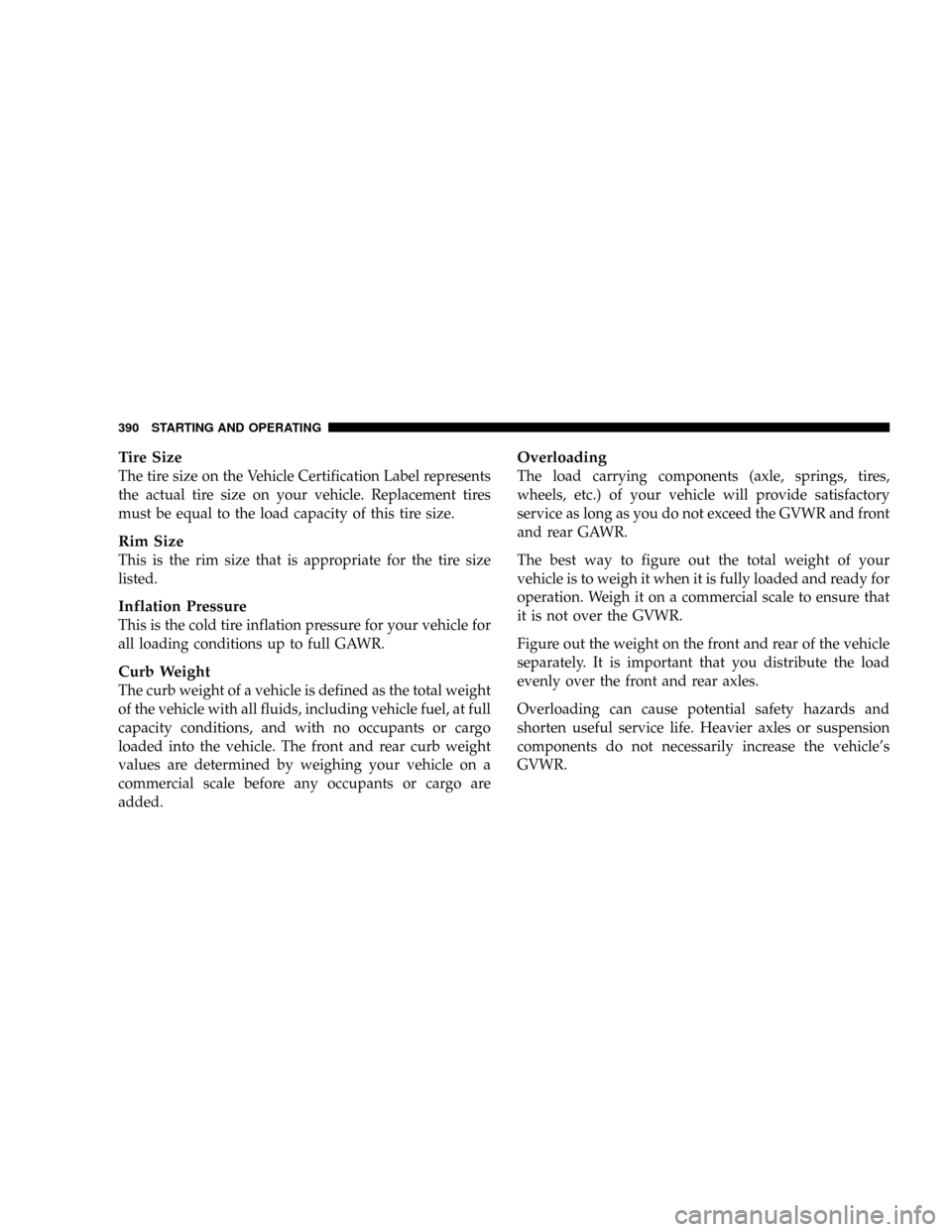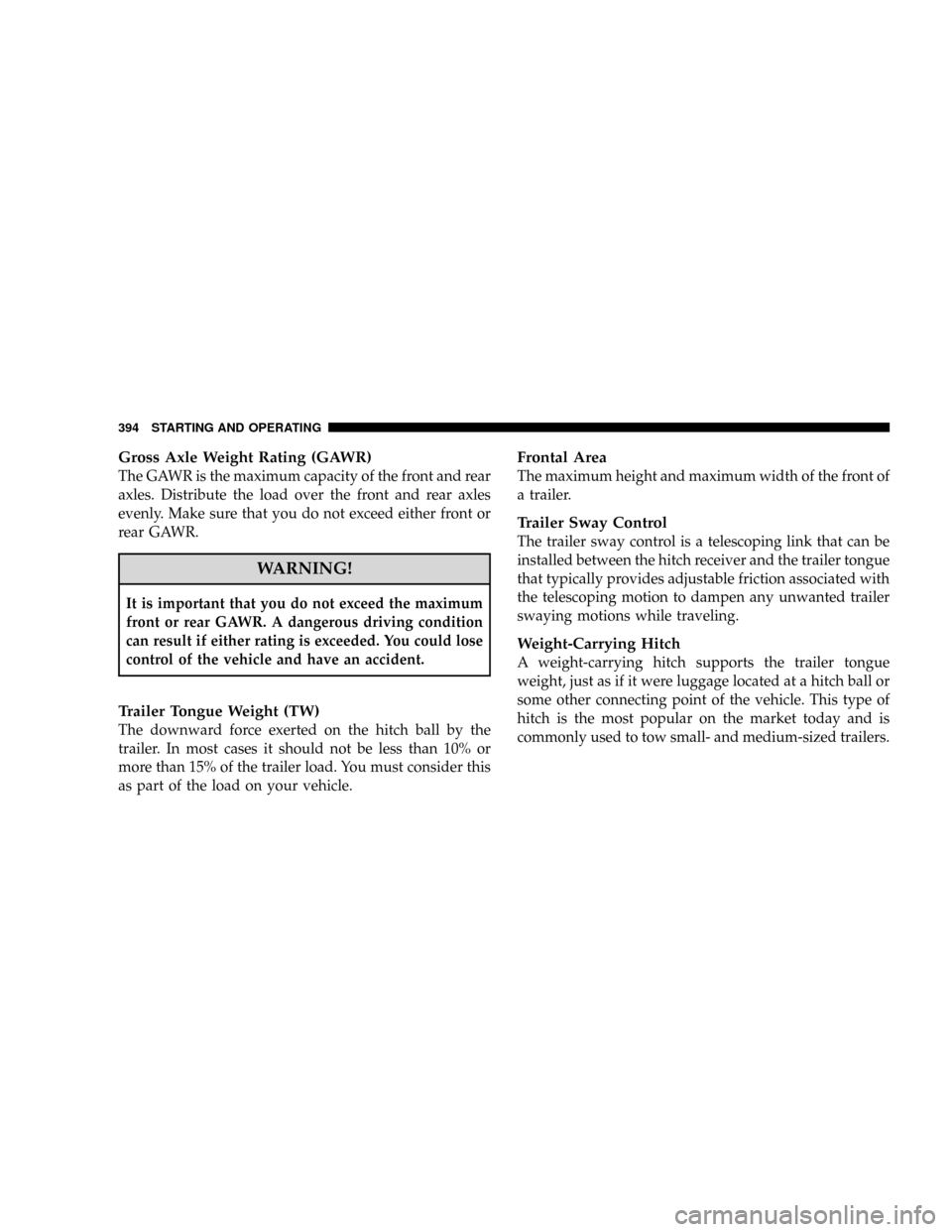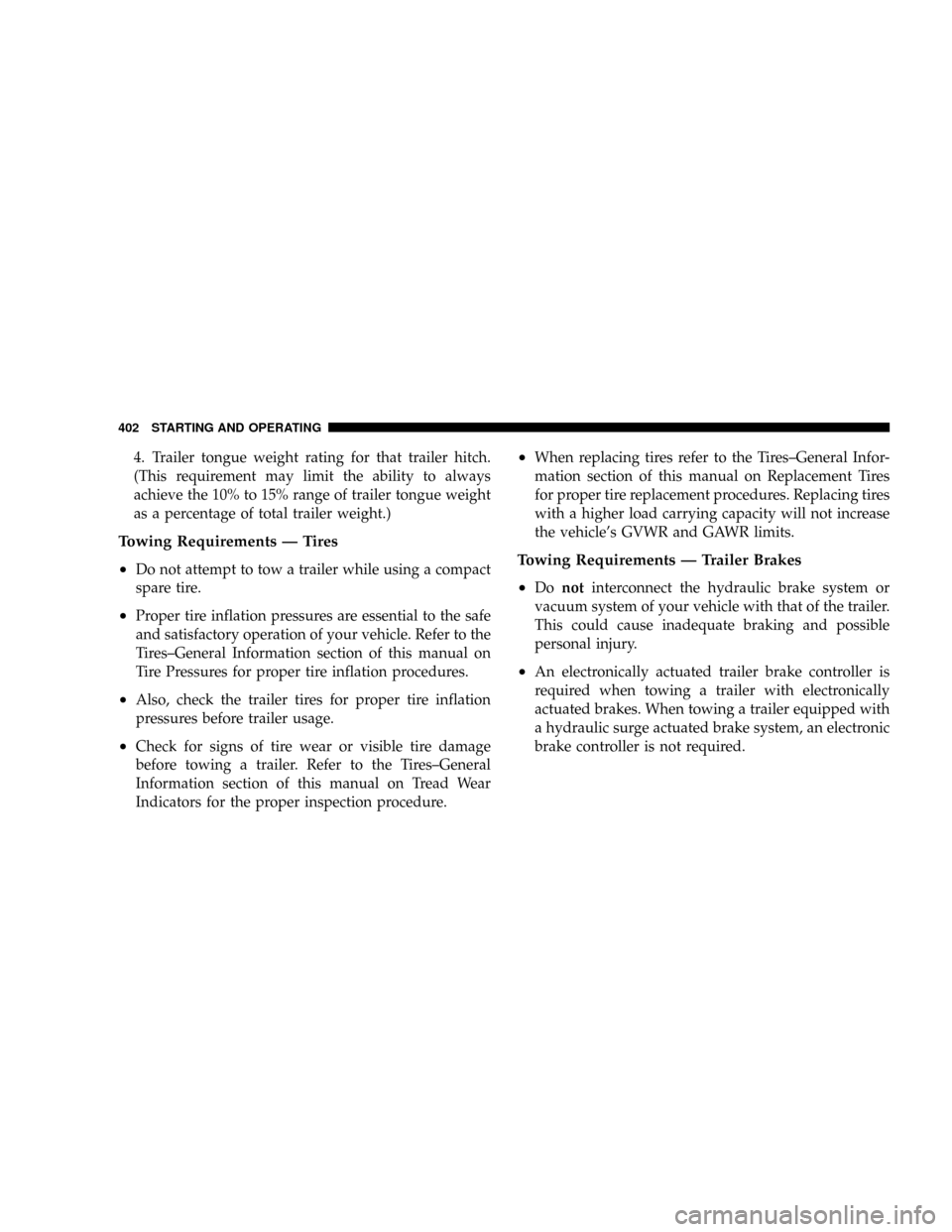Page 392 of 531

Tire Size
The tire size on the Vehicle Certification Label represents
the actual tire size on your vehicle. Replacement tires
must be equal to the load capacity of this tire size.
Rim Size
This is the rim size that is appropriate for the tire size
listed.
Inflation Pressure
This is the cold tire inflation pressure for your vehicle for
all loading conditions up to full GAWR.
Curb Weight
The curb weight of a vehicle is defined as the total weight
of the vehicle with all fluids, including vehicle fuel, at full
capacity conditions, and with no occupants or cargo
loaded into the vehicle. The front and rear curb weight
values are determined by weighing your vehicle on a
commercial scale before any occupants or cargo are
added.
Overloading
The load carrying components (axle, springs, tires,
wheels, etc.) of your vehicle will provide satisfactory
service as long as you do not exceed the GVWR and front
and rear GAWR.
The best way to figure out the total weight of your
vehicle is to weigh it when it is fully loaded and ready for
operation. Weigh it on a commercial scale to ensure that
it is not over the GVWR.
Figure out the weight on the front and rear of the vehicle
separately. It is important that you distribute the load
evenly over the front and rear axles.
Overloading can cause potential safety hazards and
shorten useful service life. Heavier axles or suspension
components do not necessarily increase the vehicle's
GVWR.
390 STARTING AND OPERATING
Page 396 of 531

Gross Axle Weight Rating (GAWR)
The GAWR is the maximum capacity of the front and rear
axles. Distribute the load over the front and rear axles
evenly. Make sure that you do not exceed either front or
rear GAWR.
WARNING!
It is important that you do not exceed the maximum
front or rear GAWR. A dangerous driving condition
can result if either rating is exceeded. You could lose
control of the vehicle and have an accident.
Trailer Tongue Weight (TW)
The downward force exerted on the hitch ball by the
trailer. In most cases it should not be less than 10% or
more than 15% of the trailer load. You must consider this
as part of the load on your vehicle.
Frontal Area
The maximum height and maximum width of the front of
a trailer.
Trailer Sway Control
The trailer sway control is a telescoping link that can be
installed between the hitch receiver and the trailer tongue
that typically provides adjustable friction associated with
the telescoping motion to dampen any unwanted trailer
swaying motions while traveling.
Weight-Carrying Hitch
A weight-carrying hitch supports the trailer tongue
weight, just as if it were luggage located at a hitch ball or
some other connecting point of the vehicle. This type of
hitch is the most popular on the market today and is
commonly used to tow small- and medium-sized trailers.
394 STARTING AND OPERATING
Page 404 of 531

4. Trailer tongue weight rating for that trailer hitch.
(This requirement may limit the ability to always
achieve the 10% to 15% range of trailer tongue weight
as a percentage of total trailer weight.)
Towing Requirements Ð Tires
²
Do not attempt to tow a trailer while using a compact
spare tire.
²Proper tire inflation pressures are essential to the safe
and satisfactory operation of your vehicle. Refer to the
Tires±General Information section of this manual on
Tire Pressures for proper tire inflation procedures.
²Also, check the trailer tires for proper tire inflation
pressures before trailer usage.
²Check for signs of tire wear or visible tire damage
before towing a trailer. Refer to the Tires±General
Information section of this manual on Tread Wear
Indicators for the proper inspection procedure.
²When replacing tires refer to the Tires±General Infor-
mation section of this manual on Replacement Tires
for proper tire replacement procedures. Replacing tires
with a higher load carrying capacity will not increase
the vehicle's GVWR and GAWR limits.
Towing Requirements Ð Trailer Brakes
²
Donotinterconnect the hydraulic brake system or
vacuum system of your vehicle with that of the trailer.
This could cause inadequate braking and possible
personal injury.
²An electronically actuated trailer brake controller is
required when towing a trailer with electronically
actuated brakes. When towing a trailer equipped with
a hydraulic surge actuated brake system, an electronic
brake controller is not required.
402 STARTING AND OPERATING
Page 405 of 531
²Trailer brakes are recommended for trailers over 1,000
lbs (454 kg) and required for trailers in excess of 2,000
lbs (907 kg).
CAUTION!
If the trailer weighs more than 1,000 lbs (454 kg)
loaded, it should have its own brakes and they
should be of adequate capacity. Failure to do this
could lead to accelerated brake lining wear, higher
brake pedal effort, and longer stopping distances.
WARNING!
Do not connect trailer brakes to your vehicle's hy-
draulic brake lines. It can overload your brake sys-
tem and cause it to fail. You might not have brakes
when you need them and could have an accident.
Towing any trailer will increase your stopping dis-
tance. When towing you should allow for additional
space between your vehicle and the vehicle in front
of you. Failure to do so could result in an accident.
STARTING AND OPERATING 403
5
Page 526 of 531

Synthetic Engine Oil...................... 444
System, Navigation...................... 283
System, Remote Starting.................... 28
Tachometer............................ 229
Temperature Control, Automatic (ATC)........ 309
Temperature Gauge, Engine Coolant........226,411
Tether Anchor, Child Restraint............... 86
Tilt Steering Column..................... 171
Tip Start............................... 13
Tire and Loading Information Placard......... 353
Tire Identification Number (TIN)............. 352
Tire Markings.......................... 348
Tire Safety Information.................... 348
Tires ............................94,357,505
Aging (Life of Tires).................... 364
Air Pressure.......................... 357
Alignment........................... 366
Chains.............................. 367Changing............................ 412
Compact Spare........................ 361
Flat Changing........................ 422
General Information.................... 357
High Speed.......................... 360
Inflation Pressures..................... 358
Jacking...........................412,415
Life of Tires.......................... 364
Load Capacity.....................353,354
Pressure Monitor System (TPMS)........... 369
Quality Grading....................... 505
Radial.............................. 361
Replacement......................... 365
Rotation............................. 368
Safety...........................348,357
Sizes............................... 350
Snow Tires........................... 368
Spare Tire........................... 414
Spinning............................ 363
524 INDEX